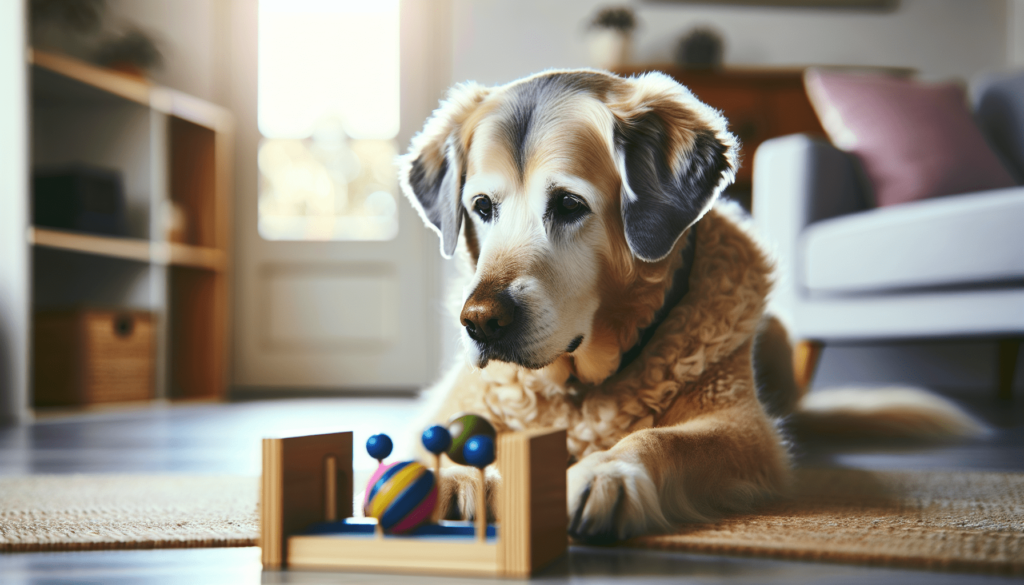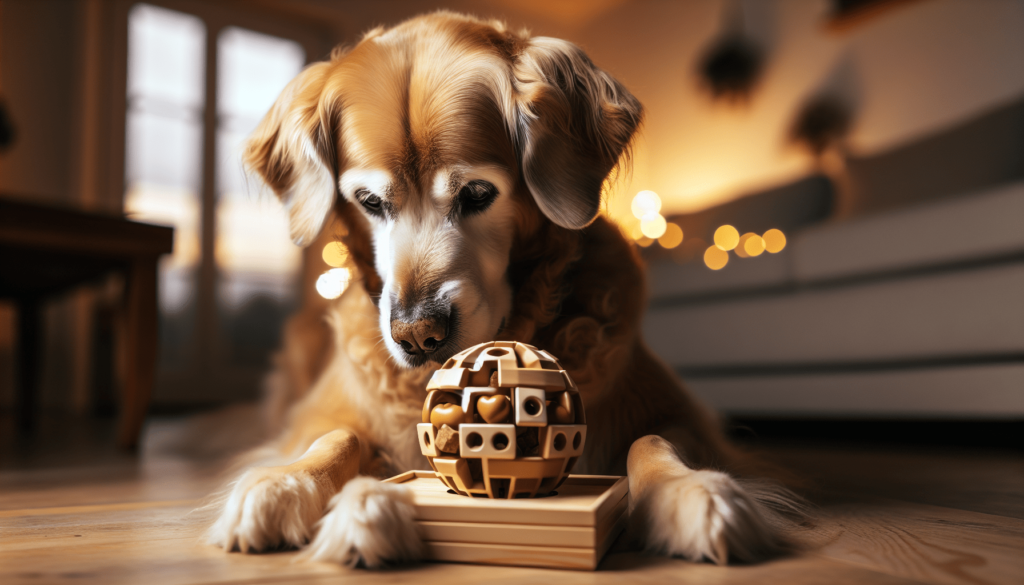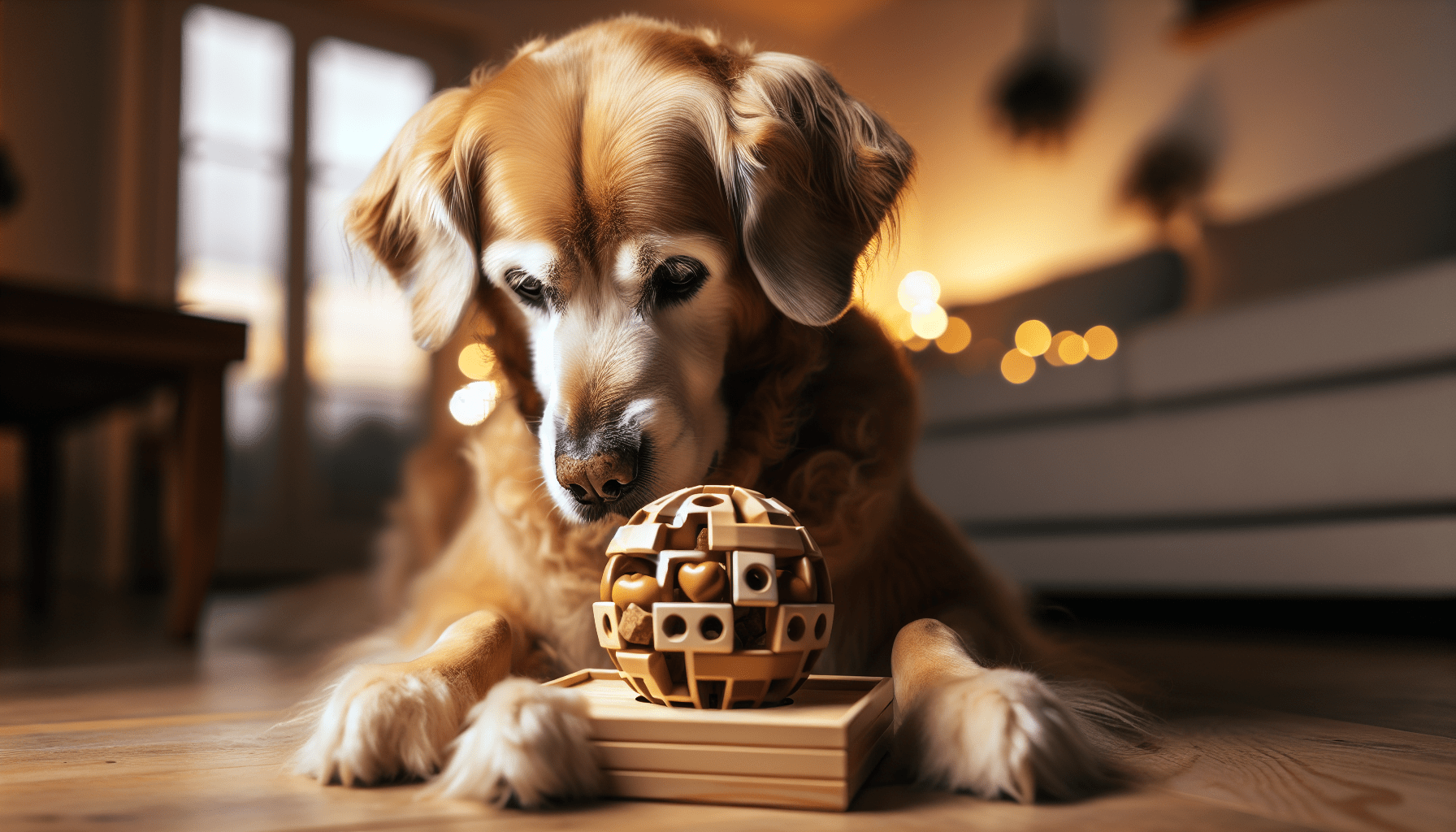As your furry companion ages, it’s important to ensure their mental sharpness stays intact. After all, they’ve been a faithful friend, always there for you. In this article, we’ll explore the most effective ways you can help keep your beloved dog mentally sharp as they grow older. From engaging in interactive toys to providing mental stimulation through training exercises, you’ll discover simple yet impactful strategies to keep their minds active and enriched. So, grab a cozy spot with your loyal companion and let’s embark on this journey together, ensuring a fulfilling and mentally stimulating life for your aging dog.

Providing Physical Exercise
Regular walks
Regular walks are an essential part of keeping your dog physically fit and mentally sharp as they age. Taking your dog on daily walks not only provides them with exercise, but it also allows them to explore their surroundings and stimulate their senses. It gives them the opportunity to encounter different sights, sounds, and smells, which can keep their mind engaged and prevent mental stagnation. Walking also helps maintain healthy joints and muscles, promoting overall wellness and longevity for your furry friend.
Engaging in playtime
Playtime is not just for puppies! As dogs age, it’s crucial to continue engaging in playtime activities to keep their minds and bodies active. Whether it’s chasing a ball, playing tug-of-war, or engaging in interactive games with their favorite toys, playtime provides mental stimulation and physical exercise. It also strengthens the bond between you and your dog, creating a sense of companionship and happiness.
Agility exercises
Agility exercises are an excellent way to challenge your dog’s mind and body. These exercises involve navigating through an obstacle course, which can include jumps, tunnels, weave poles, and more. Agility exercises improve your dog’s coordination, balance, and problem-solving skills. They also provide an outlet for their energy and can be a fun and rewarding activity to do together.
Mental Stimulation
Interactive toys
Interactive toys are a fantastic way to keep your dog mentally sharp as they age. These toys are designed to challenge your dog’s problem-solving abilities and are often equipped with puzzles or hidden treats that require them to figure out how to access the reward. Interactive toys engage your dog’s mind, preventing boredom and encouraging them to think and strategize.
Puzzle games
Puzzle games are another great way to provide mental stimulation for your aging dog. These games often involve tasks that require your dog to find hidden treats or solve a series of puzzles to reach a reward. Puzzle games can help keep their minds sharp by engaging their problem-solving and memory skills, promoting mental agility, and preventing cognitive decline.
Hide and seek
Playing hide and seek with your dog is not only a fun game but also a great way to provide mental stimulation. Hide and seek can be as simple as hiding treats around the house or playing a game of hide and seek in the backyard. It encourages your dog to use their sense of smell and sharpens their cognitive abilities as they search for the hidden treasures. This game keeps their mind active and stimulated, preventing boredom and promoting mental well-being.
Training and Learning
Teaching new tricks
Teaching your aging dog new tricks is an excellent way to keep their mind sharp and engaged. While they may not pick up new tricks as quickly as they did when they were younger, the process of learning and practicing stimulates their brain and prevents cognitive decline. Teaching new tricks also strengthens the bond between you and your dog and provides them with a sense of accomplishment.
Obedience training
Obedience training is not just for puppies! It is equally important for older dogs to continue their training and reinforce good behavior. Regular obedience training sessions not only keep your dog mentally stimulated but also ensure they have good manners and are well-behaved in various situations. Training provides mental exercise, engages problem-solving skills, and enhances focus and concentration.
Scent detection
Scent detection activities can offer mental stimulation for aging dogs as they tap into their natural instincts and abilities. You can start by hiding treats or toys around the house and encouraging your dog to use their nose to find them. As they progress, you can introduce more challenging scent detection exercises, such as searching for specific scents or participating in scent-based competitions. Scent detection engages their senses and keeps their minds sharp and focused.
Sensory Enrichment
Exploring new environments
Taking your aging dog to new environments and allowing them to explore unfamiliar surroundings can provide valuable sensory enrichment. Whether it’s a trip to a park, a hike in the woods, or a visit to a different neighborhood, exposing your dog to new sights, sounds, and smells stimulates their senses and keeps their mind engaged. It can also help prevent anxiety or boredom while providing them with a sense of adventure and discovery.
Going on car rides
Car rides can be a simple yet effective way to provide sensory enrichment for your aging dog. The sights and sounds they experience while riding in the car can stimulate their senses and keep their minds active. Taking your dog on short car rides to different locations or even just around the block can provide them with new stimuli and prevent mental stagnation.
Interactive sniffing games
Interactive sniffing games are a great way to engage your dog’s sense of smell and provide mental stimulation. You can hide treats or toys in the yard or around the house and encourage your dog to use their nose to find them. This activity taps into their natural instinct to search and hunt, keeping their mind sharp and their senses heightened. Interactive sniffing games provide both physical and mental exercise while offering a fun and rewarding experience for your aging dog.

Food Puzzles and Treat Dispensing Toys
Slow feeder bowls
Slow feeder bowls are specially designed bowls that require your dog to work for their food. These bowls have obstacles or ridges that slow down their eating and make mealtime more challenging and engaging. Using a slow feeder bowl not only prevents your dog from gobbling up their food too quickly, which can lead to digestive issues, but also provides mental stimulation as they figure out how to access their food.
Puzzle treat dispensers
Puzzle treat dispensers are toys that hold treats and require your dog to manipulate the toy to release the treats. These toys come in various shapes and designs, with different levels of difficulty. Puzzle treat dispensers challenge your dog’s problem-solving abilities and keep their mind sharp as they figure out how to obtain their rewards. It also helps prevent boredom and encourages them to stay mentally active.
Frozen food toys
Frozen food toys are a tasty and refreshing way to provide mental stimulation for your aging dog. You can stuff toys with wet dog food or make frozen treats using ingredients like plain yogurt or broth. Freezing the treats not only makes them last longer but also adds an additional level of challenge for your dog. The act of licking and manipulating the frozen food stimulates their mind and keeps them occupied, preventing boredom and mental decline.
Social Interaction
Playdates with other dogs
Social interaction is crucial for the mental well-being of your aging dog. Setting up playdates with other friendly and compatible dogs provides them with social stimulation and keeps their mind engaged. Dogs are naturally social animals, and interacting with their canine peers allows them to practice their social skills, communicate with others, and engage in play. It also provides them with much-needed exercise and can prevent loneliness or depression.
Visiting dog parks
Visiting dog parks offers numerous benefits for aging dogs. It provides them with an opportunity to interact with other dogs, socialize, and engage in physical exercise. Dog parks also offer a variety of sights, smells, and sounds, stimulating their senses and keeping their minds sharp. It’s essential to supervise your dog closely at the park and ensure they are comfortable in the environment, as some older dogs may be more sensitive to crowded or boisterous spaces.
Enrolling in group training classes
Enrolling your aging dog in group training classes can offer both mental stimulation and social interaction. These classes focus on obedience training, but they also provide an opportunity for your dog to socialize with other dogs and learn in a group setting. Group training classes expose your dog to different environments, distractions, and interactions, which can sharpen their mental acuity and enhance their social skills. It also provides a structured routine and a sense of purpose for them.
Regular Veterinary Check-ups
Monitoring cognitive health
Regular veterinary check-ups are essential for monitoring your aging dog’s cognitive health. Your veterinarian can assess their overall well-being and detect any early signs of cognitive decline or other age-related concerns. They can conduct cognitive function tests, evaluate behavior changes, and provide guidance on how to keep your dog mentally sharp as they age. Regular check-ups allow for early intervention and can improve the quality of life for your furry companion.
Addressing age-related concerns
As your dog ages, they may develop various age-related concerns such as arthritis, vision or hearing impairment, or cognitive decline. Regular veterinary check-ups ensure that these concerns are addressed promptly and that appropriate measures are taken to manage them effectively. Your veterinarian can provide guidance on lifestyle modifications, dietary changes, and medical interventions that can support their overall health and well-being. Addressing age-related concerns promptly can help maintain your dog’s quality of life and keep them mentally sharp.
Modifying care plan if needed
During regular veterinary check-ups, your veterinarian may recommend modifications to your aging dog’s care plan based on their changing needs. This may include adjustments to their diet, exercise routine, or medication regimen. Modifying the care plan ensures that your dog’s specific needs are met as they age, helping them stay mentally sharp and physically healthy. Your veterinarian can guide you through these changes and provide personalized recommendations for your furry friend.
Massage and Touch Therapies
Gentle massages
Gentle massages are not only relaxing but also provide numerous benefits for your aging dog. Massaging your dog stimulates their muscles, improves blood circulation, and reduces muscle tension or stiffness. It also releases endorphins, which can elevate their mood and promote a sense of well-being. Gentle massages can help your dog relax, reduce anxiety, and provide mental stimulation through the power of touch.
Brushing and grooming sessions
Regular brushing and grooming sessions offer more than just a tidy appearance for your aging dog. Brushing stimulates their skin, improves blood flow, and promotes a healthy coat. It also provides an opportunity for bonding and social interaction, as your dog enjoys the close physical contact with you. Grooming sessions can be mentally stimulating for your dog, especially if they are introduced to grooming at an early age. It keeps their minds engaged and helps them remain sharp as they age.
Acupressure and TTouch techniques
Acupressure and TTouch techniques involve applying gentle pressure to specific points on your dog’s body to promote relaxation and healing. These techniques can help alleviate pain, reduce anxiety, and improve overall well-being. Acupressure and TTouch stimulate your dog’s nervous system and release endorphins, providing them with mental and physical benefits. Learning and practicing these techniques can be a bonding experience for both you and your dog and provide valuable mental stimulation.
Maintaining a Consistent Routine
Regular feeding and exercise times
Maintaining a consistent routine is essential for your aging dog’s mental well-being. Having regular feeding and exercise times provides structure and stability in their daily lives. It helps them anticipate and prepare for activities, keeping their minds engaged and preventing anxiety or restlessness. Consistency in their routine ensures that they receive the appropriate amount of physical exercise and mental stimulation, promoting their overall health and happiness.
Scheduled mental stimulation activities
In addition to regular feeding and exercise times, scheduling specific mental stimulation activities is equally important. By incorporating puzzles, training sessions, or interactive playtime into their daily routine, you provide them with regular mental exercise and stimulation. Having these activities at designated times allows your dog to anticipate and look forward to them, keeping their minds sharp and focused. Consistency in mental stimulation activities strengthens their cognitive abilities and helps maintain their mental sharpness as they age.
Establishing predictable patterns
Establishing predictable patterns in your aging dog’s daily life can bring a sense of security and familiarity. Dogs thrive on routine, and having predictable patterns helps reduce anxiety and stress. For example, feeding your dog at the same time each day, going for walks at designated times, and having consistent playtime routines create a sense of structure and stability. Predictable patterns provide mental stimulation by allowing your dog to anticipate and participate in familiar activities, promoting their overall well-being.
Adapting to Their Changing Abilities
Modifying exercises and activities
As your dog ages, it’s crucial to adapt their exercises and activities to suit their changing abilities. This may involve reducing the intensity or duration of physical exercises, selecting low-impact activities, or avoiding exercises that put too much strain on their joints. It’s important to monitor your dog’s comfort levels and consult with your veterinarian to ensure their activities are appropriate for their age and health. Modifying exercises and activities allows your dog to continue engaging in physical and mental stimulation while maintaining their safety and well-being.
Using adaptive equipment
Using adaptive equipment can help support your aging dog’s changing abilities while keeping them mentally and physically active. For dogs with mobility issues or joint pain, ramps or stairs can be used to provide easier access to furniture or outdoor spaces. Puzzle toys or treat dispensers can be adapted to accommodate any physical limitations, allowing your dog to continue enjoying mental stimulation. Adaptive equipment ensures that your dog can participate in activities comfortably and helps maintain their independence and mental sharpness.
Providing additional support and assistance
As your dog ages, they may require additional support and assistance to stay mentally sharp. This could involve providing them with orthopedic beds or ramps to make their environment more comfortable and accessible. If your dog experiences vision or hearing loss, you can use visual or auditory cues during training or playtime to help them navigate and engage with their surroundings. Providing additional support and assistance ensures that your dog can continue to enjoy mental stimulation and maintain their cognitive abilities as they age.

